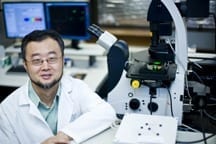
Cells from one’s own blood could be converted into a treatment for autoimmune diseases, like rheumatoid arthritis and Crohn’s disease, based on the discovery of a Purdue University researcher.
Chang Kim, a professor of comparative pathobiology, has created a way to direct the differentiation of T-cells, a white blood cell that is a key player in the body’s immune system. The method uses naïve T-cells, immature cells from which all T-cells develop, and induces them to become suppressive T-cells that block the development of painful inflammation associated with autoimmune diseases.
Naïve T-cells can be gathered from a patient’s blood, treated and then re-injected, said Kim, who also is a university faculty scholar and member of Purdue’s Center for Cancer Research and Weldon School of Biomedical Engineering.
“These cells are being directed to become a type of cell that is already present in our bodies, where a fine balance between inflammatory T-cells and suppressive T-cells is maintained,” he said. “We are just tipping the scales in favor of suppressive T-cells to reduce inflammation. Because of this there are none of the toxic side effects associated with many immune-suppressive drugs. In addition, cells from one’s own body aren’t rejected and remain in the body much longer. Instead of taking a pill every day, this could lead to a treatment administered, for example, every six months.”
Autoimmune diseases occur when the immune system attacks one’s own body instead of fending off infection from viruses, bacteria and other foreign cells. An overactive immune system sends T-cells to healthy tissue and organs where they cause inflammation and tissue destruction.
Suppressive T-cells migrate to areas of inflammation and suppress the T-cells there without significantly lowering the number of T-cells in other areas of the body where they are needed for proper immune function, Kim said.
“Treatment with suppressive T-cells has the potential to be a much more precise and targeted regulation of immune function than what currently exists,” he said. “Treating autoimmune diseases without compromising a patient’s immune system has been a big problem in the field. We need to catch the thief without taking down the house, and this has that potential.”
Kim discovered that naïve T-cells cultured in the presence of the hormone progesterone can be induced to become suppressive T-cells.
The Latest Bing News on:
Autoimmune disease treatment
- How Is Lyme Disease Treated?on April 27, 2024 at 10:00 am
Lyme disease is a bacterial illness spread by deer ticks. Antibiotics are the primary Lyme disease treatment, but home remedies can help.
- Anti-Inflammatory Use May Reduce PD Risk in Patients With Autoimmune Diseaseson April 26, 2024 at 6:33 am
Researchers examined the relationship between exposure to anti-inflammatory therapy and the incidence of Parkinson disease in patients with autoimmune conditions.
- Irregular bone marrow cells may increase heart disease riskon April 26, 2024 at 4:00 am
Over time, bone marrow stem cells develop key genetic errors and pass them on to immune cells. This may increase the risk of developing heart disease.
- Immune cells play a bigger role in high blood pressure than previously thought, opening doors for new treatmentson April 25, 2024 at 11:34 pm
A review in Nature Reviews Nephrology presents the association between immune cells and the development of hypertension, suggesting potential new therapeutic targets to mitigate the disease by ...
- How mRNA Is Rewriting the Rules of Cancer Treatmenton April 24, 2024 at 2:24 pm
MIT spinout Strand Therapeutics has developed a new class of mRNA molecules that can sense where they are in the body, for more targeted and powerful treatments. What if training your immune system to ...
- Existing drugs studied in patients with rare immune diseaseson April 24, 2024 at 5:48 am
Science X is a network of high quality websites with most complete and comprehensive daily coverage of the full sweep of science, technology, and medicine news ...
- Fate Therapeutics Announces Presentation of FT819 Proof-of-Concept Data for B cell-mediated Autoimmune Diseases at ASGCT Annual Meetingon April 22, 2024 at 3:30 pm
Key Therapeutic Mechanisms of Clinical Activity for Autoimmune Diseases, including B cell Depletion, Tissue Infiltration and Immune ...
- Novel cell therapy treatments offer promise to immune-compromised childrenon April 18, 2024 at 10:03 am
In a first-of-its-kind clinical trial, researchers found that intravenous therapies made from virus-specific T-cells (VST) can effectively treat immunocompromised pediatric patients, far surpassing ...
- Heart disease: How the DASH diet can help lower the risk after breast cancer treatmenton April 17, 2024 at 1:03 am
Researchers say women who've been treated for breast cancer can lower their risk of cardiovascular disease by following the DASH and other healthy diets ...
- Cullinan changes name, pivots to autoimmune diseaseon April 16, 2024 at 8:14 am
The biotech says a dual-pronged antibody it’s developing could become an “off-the-shelf” alternative to cell therapies in development for lupus and other inflammatory conditions.
The Latest Google Headlines on:
Autoimmune disease treatment
[google_news title=”” keyword=”autoimmune disease treatment” num_posts=”10″ blurb_length=”0″ show_thumb=”left”]
The Latest Bing News on:
Autoimmune disease
- COVID patient's strange symptoms save her from deadly undiagnosed diseases. Here's what doctors discovered.on April 26, 2024 at 5:33 pm
Vicky Dennis went to the hospital with strange symptoms when she had COVID. Doctors found she had two undiagnosed, life-threatening diseases and needed a liver transplant to survive.
- Experts develop immune-enhancing therapies to target tuberculosison April 26, 2024 at 3:10 pm
Experts are working on novel immune-enhancing therapies called host-directed therapies to use the body's own immune system to target tuberculosis, with hopes that they could tackle even the ...
- Anti-Inflammatory Use May Reduce PD Risk in Patients With Autoimmune Diseaseson April 26, 2024 at 6:33 am
Researchers examined the relationship between exposure to anti-inflammatory therapy and the incidence of Parkinson disease in patients with autoimmune conditions.
- What It’s Like to Live With Neurologic Lyme Disease: A Patient Perspectiveon April 26, 2024 at 6:24 am
Diagnosing patients with neurologic Lyme disease can take upwards of 2 years, which Maria Arini Lopez discovered first-hand in the spring of 2021.
- Immune cells play a bigger role in high blood pressure than previously thought, opening doors for new treatmentson April 25, 2024 at 11:34 pm
A review in Nature Reviews Nephrology presents the association between immune cells and the development of hypertension, suggesting potential new therapeutic targets to mitigate the disease by ...
- Yoga practices to follow to manage autoimmune disorderson April 25, 2024 at 8:30 pm
Yoga helps manage autoimmune conditions by promoting relaxation, reducing inflammation, and supporting well-being. Techniques include gentle poses, de ...
- Fever, swollen glands, fatigue, rash and joint pain? Know how to identify autoimmune diseaseson April 25, 2024 at 6:45 pm
What complicates matters is that symptoms may overlap with other diseases and triggers may be unknown, says internal medicine expert Dr Suranjit Chatterjee ...
- Patients of autoimmune liver disease treated with immune suppressants have lower prevalence of apical periodontitis: Studyon April 24, 2024 at 6:30 am
Patients of autoimmune liver disease treated with immune suppressants have a lower prevalence of apical periodontitis suggests a study published in the Journal of Endodontics.Autoimmune ...
- Existing drugs studied in patients with rare immune diseaseson April 24, 2024 at 5:48 am
Science X is a network of high quality websites with most complete and comprehensive daily coverage of the full sweep of science, technology, and medicine news ...
- Taking stock of the frenzied push into autoimmune diseaseon April 18, 2024 at 6:13 am
This is the online edition of Adam’s Biotech Scorecard, a new subscriber-only newsletter. STAT+ subscribers can sign up here to get it delivered every Thursday to their inbox. Good morning! This is a ...
The Latest Google Headlines on:
Autoimmune disease
[google_news title=”” keyword=”autoimmune disease” num_posts=”10″ blurb_length=”0″ show_thumb=”left”]











